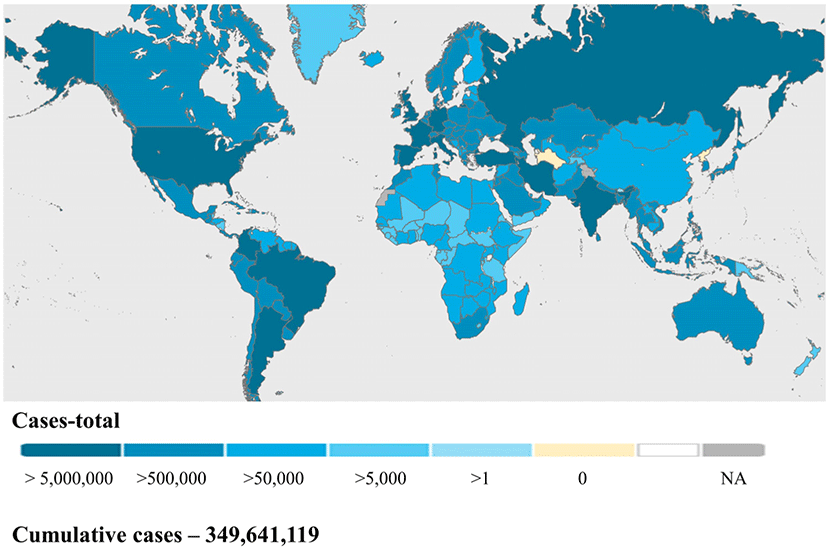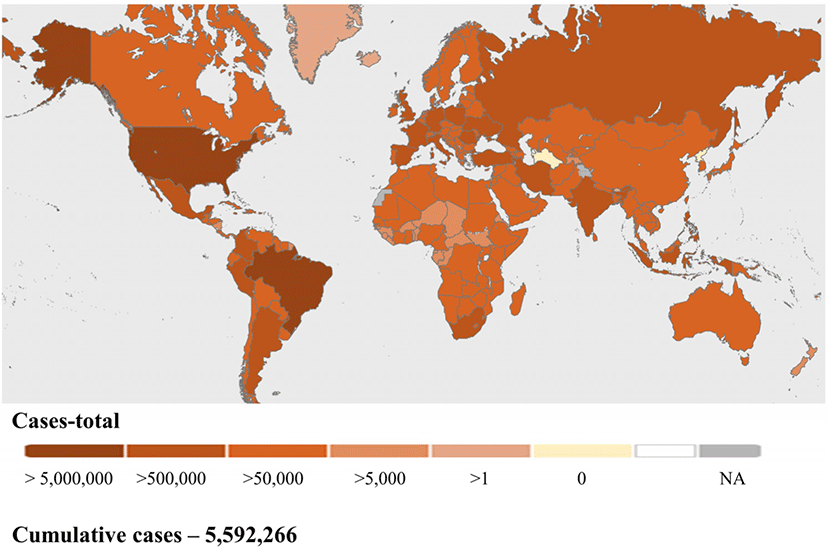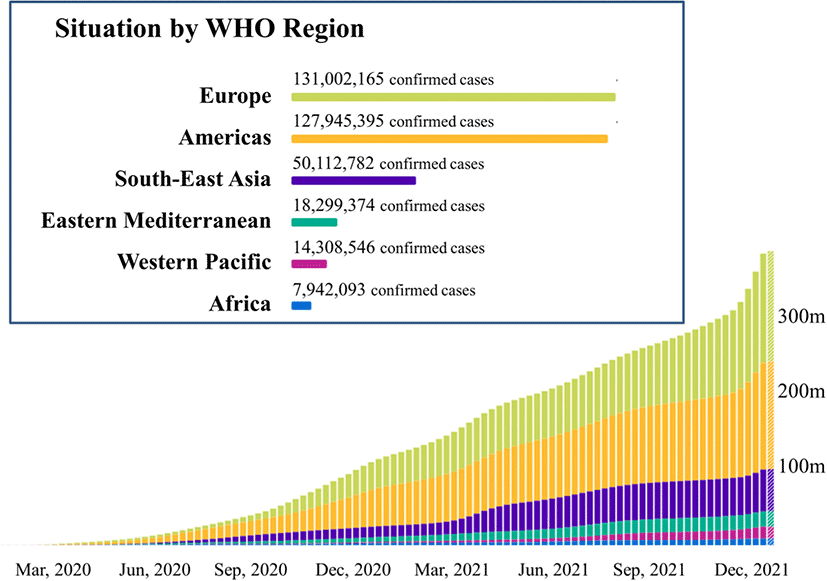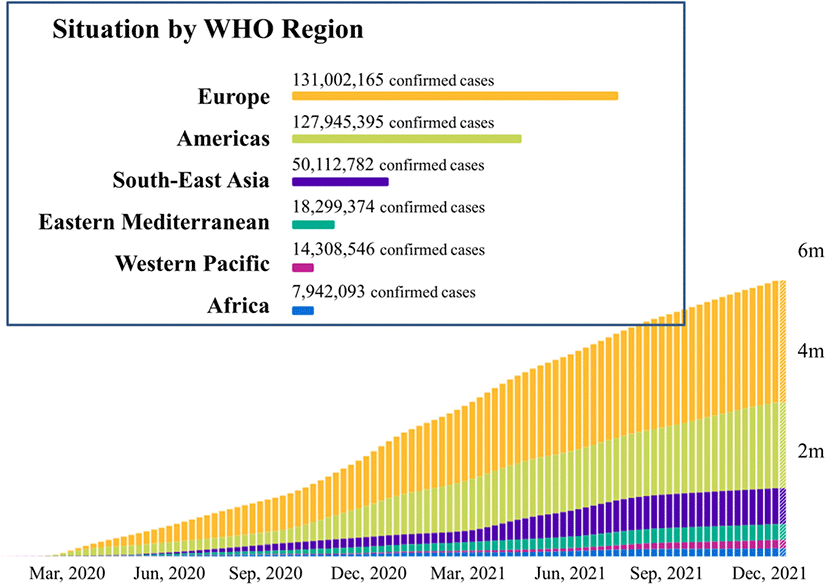1. Introduction
The coronavirus disease 2019 (COVID-19) pandemic era has lasted for more than 2 years since first case was reported in December 2019.[1] Viral factors of severe acute respiratory syndrome coronavirus 2 (SARS-CoV-2) and host defense strategies have been developed during the COVID-19 pandemic.[2] In order to sustain and spread infections, the virus constantly developed novel variants.[3] Such variants have been reported as the alpha, beta, delta, and omicron SARS-CoV-2.[4, 5] By the end of December 2021, the omicron variant consisted of about 95% of the total COVID-19 confirmed cases.[6] Compared to the delta variant, the omicron variant presented a higher breakthrough of infections in the vaccinated population, while showing a milder clinical severity with less admission (odds ratio [OR], 0.33; 95% confidence interval [CI], 0.21- 0.52), less intensive care admission (OR, 0.38; 95% CI, 0.17 to 0.87), and less mortality rate (OR, 0.26; 95% CI, 0.06-1.02).[6]
Efforts to suppress the COVID-19 infection and mortality have been introduced including quarantine and vaccinations.[7] Governments and public strategies have executed quarantine measures, such as selective or transient lockdown periods, social distancing, enforcing wearing of facial masks, and other preventive measures.[8, 9] A various types of vaccines against the SARS-CoV-2 have been developed to prevent transmission of SARS-CoV-2 and clinically serious disease [10] Moreover, pharmaceutical therapeutics against COVID-19 became available, although with limited efficiency in eradicating or ending the pandemic.[11] All of these host and viral factors can be seen to have influence on the epidemiology of the COVID-19.
The number of cases and severity of COVID-19 have been dynamically changing which made it challenging to be estimated. In this study, we aimed to give a long term global trend of incidences and mortality of SARS CoV-2 infection by presenting the total number of cases and mortality rate according to geographic region, ethnicity, and economic status. Many previous researches on the prevalence and mortality of COVID-19 have focused on Europe or America, which were estimated to account for about 78 % of the evidence.[12] Although there are inconsistencies in the data, the global infection fatality rate was estimated about 0.15% in 1.5 to 2.0 billion of COVID-19 cases in February 2022.[12]
This study investigated the incidence and death rate of COVID-19 based on data from the World Health Organization (WHO) from the start of the COVID-19 pandemic up to 31 January, 2022. The epidemiology of COVID-19 was analyzed according to regions, income levels, and nationalities. This epidemiologic updates on COVID-19 aims to give an insight into the ways to the endemic phase of COVID-19.
2. Methods
Global, regional and national estimates of cumulative SARS-CoV-2 infection during COVID-19 pandemic was analyzed The cumulative incidence and mortality rate of COVID-19 were calculated based on the WHO COVID-19 Dashboard data from the start of the COVID-19 pandemic to 31 January, 2022, which referred to WHO’s officially reported numbers of SARS-CoV-2 infection cases and related deaths under the International Health Regulation.
Cases primarily defined as laboratory-confirmed SARS-CoV-2 cases or deaths based on WHO’s guideline are those as the followings; [13] 1) a patient with a positive nucleic acid amplification test; 2) a patient with a positive SARS-CoV-2 antigen rapid diagnostic test and meeting either the probable case definition; or 3) an asymptomatic patient with positive SARS-CoV-2 antigen rapid diagnostic test who had contact of a probable or confirmed case. Underestimations or overestimations of truce cases and mortality may exist due to local adaptations such as testing strategies, reporting practice, lag times, and case detection methods. Such factors may have influence on collecting the accurate numbers and can possibly delay issue of global data.
All efforts from governments, international, national, and regional authorities have been made to ensure the reliability and accuracy of the dataset and significant data errors been detected by the WHO, which may be revised at more frequent intervals. The number of cumulative total confirmed cases, the number of cumulative total confirmed cases (cumulative incidence) per 100,000, the number of cumulative total death cases, and the number of cumulative total death cases (cumulative death rate) per 100,000 population were collected from WHO data and analyzed according to the regions classified by the WHO (Europe, Americas, South-East Asia, Eastern Mediterranean, Western Pacific, and Africa), income groups (high-income, upper middle-income, lower middle-income, and lower income), and each country (total of 237 countries). We systematically reviewed input registration data and all figures were generated using R software version 3.1.1 (R Foundation, Vienna, Austria).
3. Results
A total of 349,641,119 of cases were confirmed COVID-19 globally on 31 January, 2022 (Table 1 and Fig. 1). The cumulative incidence of COVID-19 was 4,485.72 people per 100,000 of the population. Among the six WHO regions, Europe demonstrated the highest cumulative incidence of COVID-19 followed by Americas (14,039.95 and 12,512.57 per 100,000 population, respectively). Cumulative total death cases related to COVID-19 is calculated as 5,592,266 (Fig. 2). The cumulative death rate of COVID-19 was 71.75 per 100,000 population and (Fig. 2 to 4). The Americas presented the highest cumulative death rate of COVID-19, followed by Europe (241.63 and 186.75 per 100,000 population, respectively).


When focusing on income levels, groups with the highest income demonstrated the highest cumulative incidence of confirmed COVID-19, followed by the upper middle-income group (42,742.51 and 33,935.34 per 100,000 population, respectively). The cumulative death rate of COVID-19 was highest in the upper middle-income group, followed by the high-income group (619.14 and 419.10 per 100,000 population, respectively).
The nation with the highest cumulative total cases of COVID-19 was the United States of America (n=69,727,991) (Table 2). However, the cumulative incidence of COVID-19 in the USA was 21,065.69 per 100,000 population and countries such as Andorra, Seychelles and Gibraltar showed higher cumulative incidence than USA and higher in other countries such as Andorra, Seychelles, and Gibraltar. The total cumulative deaths of COVID-19 was highest in United States of America (n=858,470) but the cumulative death rate of COVID-19 was highest in Peru (619.137 per 100,000 population). Republic of Korea indicated a relatively low incidence and death rate of COVID-19, demonstrating 1446.118 per 100,000 population of the cumulative incidence of COVID-19 and 12.805 per 100,000 population of the cumulative death rate of COVID-19.
Global trend of cumulative total cases of COVID-19 and cumulative total death cases can be seen in Fig. 3 and 4 respectively. Unfortunately both trends are still rising up by at the end of December 2021.


4. Discussion
Present study showed a global picture of current COVID-19 epidemiology. Not only the number of cumulative total cases but cumulative incidence shown with number of cases per 100,000 population are highest in Europe region when compared with other WHO regions. Besides high-income group had the highest number of cumulative total cases and cumulative incidence. Although Americas group comes second after Europe in mean of cumulative total cases and cumulative incidence, WHO region of Americas includes not only high-income countries like USA and Canada but also middle and lower-income countries from South and Central America. Lower-income groups and regions of Africa which mostly consists from lower-income countries had reported the lowest total cumulative cases and cumulative incidence.
When total cumulative death cases and death rate defined as total cumulative death cases per 100,000 population calculations were analyzed, different outcome was found compared with total cumulative cases and cumulative incidence. Region of Americas data showed the highest cumulative total deaths and death rate. Europe comes second after Americas in mean of these two measures of WHO dashboard. Africa and Eastern Mediterranean are at the bottom of these measure lists.
It can be assumed that the economic inequality had influence on both the incidence and death rates of COVID-19. Although disproportionate impact of COVID-19 on different countries and regions can be conceived as arising from biological and genetic differences, it mostly comes from the social determinants of health-care systems.[14, 15] It is possible that the availability to medical access for COVID-19 testing may have impact on the high incidence of COVID-19 in the high-income group. The death rates of COVID-19 were high in developing or underdeveloped countries, although the incidence of COVID-19 was higher in many advanced countries. The higher death rates in developing or underdeveloped countries could be attributed to the shortage or insufficient medical care. These results support the prior reports on the economic inequalities during the COVID-19 pandemic.[14-16]
These results must be interpreted cautiously because one country comes forward with its measures of WHO COVID-19 Dashboard and socio-demoghraphic features. USA reported highest total cumulative cases and one of the high cumulative incidence. This result is in accordance with the region of Europe because developed or high-income countries usually reported high total cumulative cases and cumulative incidence attributed to the easy access to healthcare facilities. Despite its developed situation, USA has the highest total cumulative death cases and one of the highest death rate by 259 deaths per 100,000 population. USA is accepted as richest country on earth but it has heterogeneity for its citizens in mean of access to healthcare. Especially ethnic and racial minorities are more vulnerable to COVID-19 pandemic and death rates are higher in these groups when compared with their percentage in USA’s population.[17]
Almost two and a half years have been passed during pandemic when this paper was written. In the beginning of the pandemic, questions about the duration of the pandemic cannot be answered due its ambiguous nature. Despite many restrictions and prevention strategies have been implemented by various governments or organizations and introduction of various type of vaccine against SARS-CoV-2- as can be seen in Fig. 3 and 4 pandemic is still going on. It is expected not to end but to transform into endemic state.[18]
A number of factors can have influence on the incidence of COVID-19. The variant type of SARS-CoV-2 is one of the main factors in determining the infection rates of COVID-19. In January 2022, the omicron variant, a predominant mutant type of SARS-CoV-2, emerged, which had clinical characteristics of attenuated infections with mild or absence of symptoms, while it harbors high transmission rates.[19, 20]
The status of vaccination is another factor which has influence on the incidence of COVID-19. The COVID-19 vaccination reported to be effective in preventing and attenuating the infection rates of SARS-CoV-2 in many countries.[21, 22] However, because the novel variant of SARS-CoV-2 can escape most neutralizing antibodies against SARS-CoV-2, the high number of vaccinated population cannot guarantee a lower incidence of COVID-19.[23]
Public health measures, such as wearing facial mask can also have impact on the incidence of COVID-19. It was reported that the wearing of surgical masks reduced the SARS-CoV-2 infection rate more than 50% in Denmark.[24]
Another determinant of incidence of COVID-19 is testing strategies and the types of tests. Individuals who are offered test can affect the cumulative total case number and incidence. Individuals who had symptoms and individuals who had test for screening (for example before surgical interventions or before airway travelling) will show different test results. Tests for clinical purposes must have higher sensitivity. Reverse transcriptase PCR is the recommended test type for individuals who had symptoms. On the other hand for mass screening purposes and rapid antigen tests can be chosen given the lower cost but lower sensitivity.[25] Jurisdictions and governments had chosen different testing strategies, reporting practice based on their healthcare system and resources that affect the measures. Furthermore, lag times may have increase in reporting biases.
In this study, we suggested that the death rate was relatively high in developing or underdeveloped nations. The economic inequality for medical care may induce higher mortality rate in the developing or underdeveloped nations than developed nations. In addition, the epidemic features of SARS-CoV-2 variants could result in different mortality rates according to geographic regions. Some regions assumed to consist of low-income countries like Africa had reported lower numbers for all four measures of WHO COVID-19 Dashboard. We hypothesized that this difference come from the case detection methods and access to heathcare and data collection and reporting systems of jurisdictions. These kinds of health determinant may cause biases and incidence or death rate data cannot be collected adequately.
Death rate of COVID-19 is also affected by various types of determinants. In aspects of host factors, there have been reports on the different symptomatic characteristics of COVID-19 according to ethnicities.[26] The age of patients is another key factor to determine the fatality of SARS-CoV-2 infection.[27] In previous modeling study, the infection fatality of COVID-19 was estimated to be lowest in age groups of 5 to 9 years old and it increased according to age in a log-linear pattern.[27] Because the aged population is more vulnerable to the SARS-CoV-2 infection, the availability of nursing health care system and age distribution of the population are factors that could contribute to the heterogeneous mortality rates of COVID-19 among nations. In South Korea, the medical costs for diagnosis and treatment of COVID-19 have been completely covered by the national health insurance system.[28] This health care system may lead to the results of the low death rate of COVID-19 in South Korea.
It is notable that there are additional factors to be considered when estimating the mortality rates of COVID-19 in the future. The virulence of SARS-CoV-2 has been weakening with emergence of its novel variants. In addition, vaccinations against SARS-CoV-2 effectively attenuated the severity of COVID-19.[29] Because immunity of the disease has been maintained while the infection-blocking immunity rapidly disappeared, the immunologic features of SARS-CoV-2 are predicted to change and become endemic phase of COVID-19.[30]
In this study, we reported global, regional, and national incidence and mortality of COVID-19 in 237 countries and territories up to January 2022 through a systematic analysis for WHO COVID-19 Dashboard dataset. However, these are several limitations of this study that need to be addressed. First, every effort from WHO has been made to ensure the reliability and accuracy of the dataset, significant data errors could be detected. Second, as the data was collected by WHO, governments, international, national, and regional authorities, there is the possibility that the estimates may tend to underestimate or overestimate the levels of incidence and mortality of COVID-19.
5. Conclusions
From the start of the COVID-19 pandemic up to 31 January, 2022, 349.6 million of the worldwide population suffered symptoms of SARS-COV-2 and 5.6 million lost their lives due to it. The population in Europe and other high-income groups showed high incidence rates of COVID-19 while the death rate was high in Americas and other upper middle-income groups. According to figures nationalities, the counties with compromised social and economic status presented higher death rate despite the relatively lower incidence of COVID-19 than the developed countries. The results of this study may provide crucially important for COVID-19 research and proper public health policies and strategies.
